Abstract
Baby bottle tooth decay (BBTD) is a term applied to a specific form of rampant decay associated with inappropriate bottle or breast feeding of infants and young children. Although the prevalence of BBTD has been studied in individual ethnic groups, comparison studies are rare. Head Start children have frequently served as study subjects for assessing the prevalence of BBTD. The purpose of this study was to compare BBTD and caries prevalence among Head Start children who are members of four ethnic groups in five southwestern States. Age, residence, and fluoridation status were also compared for the total sample and ethnic categories. The sampling process was a stratified random site selection; it was used to obtain data on 1,230 children. This number constituted 3 percent of the children enrolled in Head Start in Public Health Service Region VI (Arkansas, Louisiana, New Mexico, Oklahoma, and Texas) where the study was conducted. The criterion for determining the presence of BBTD was based on the number of carious deciduous maxillary incisors observed. The severity of the condition was reported as two of four and three of four of the target teeth affected. Thus, two levels of severity are reported. BBTD was prevalent in approximately 24 percent and 15 percent of the total sample, depending on the severity criterion used. Native American children had a significantly higher (P less than 0.05) prevalence than Hispanic, white, and black subjects. Rural children had significantly higher (P less than 0.05) prevalence of BBTD than nonrural children for all ethnic groups except whites.(ABSTRACT TRUNCATED AT 250 WORDS)
Full text
PDF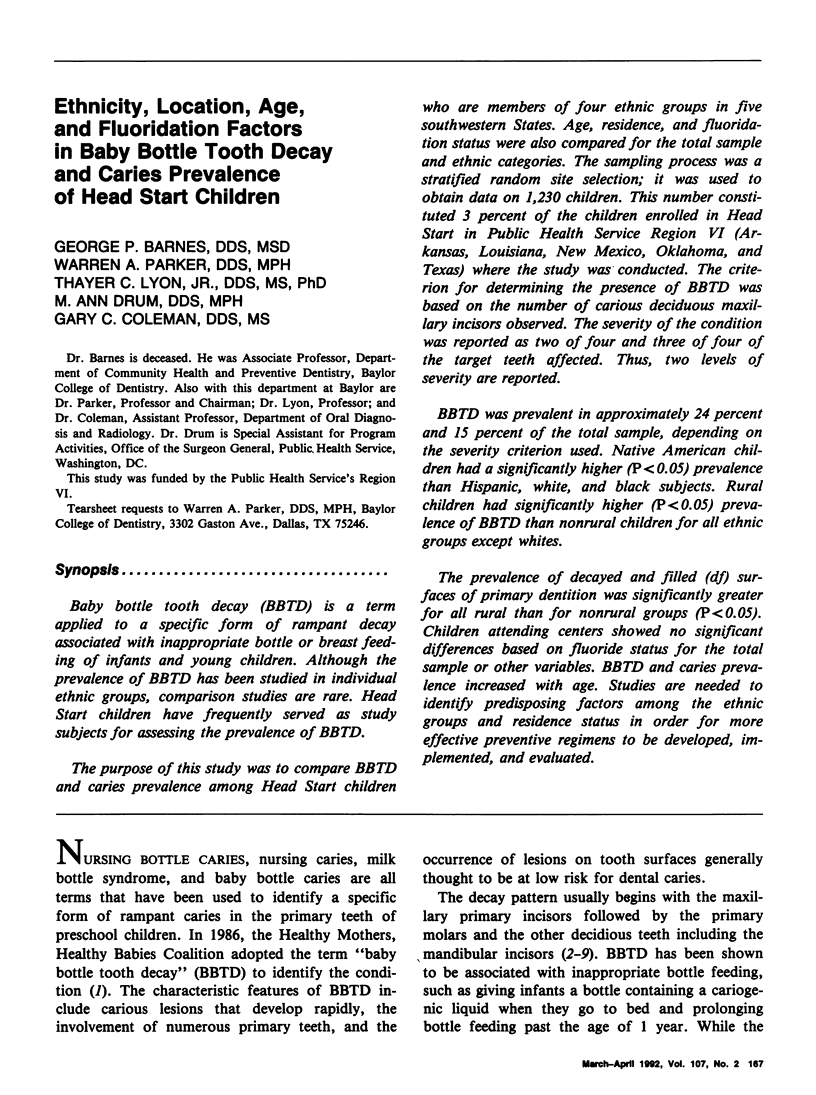
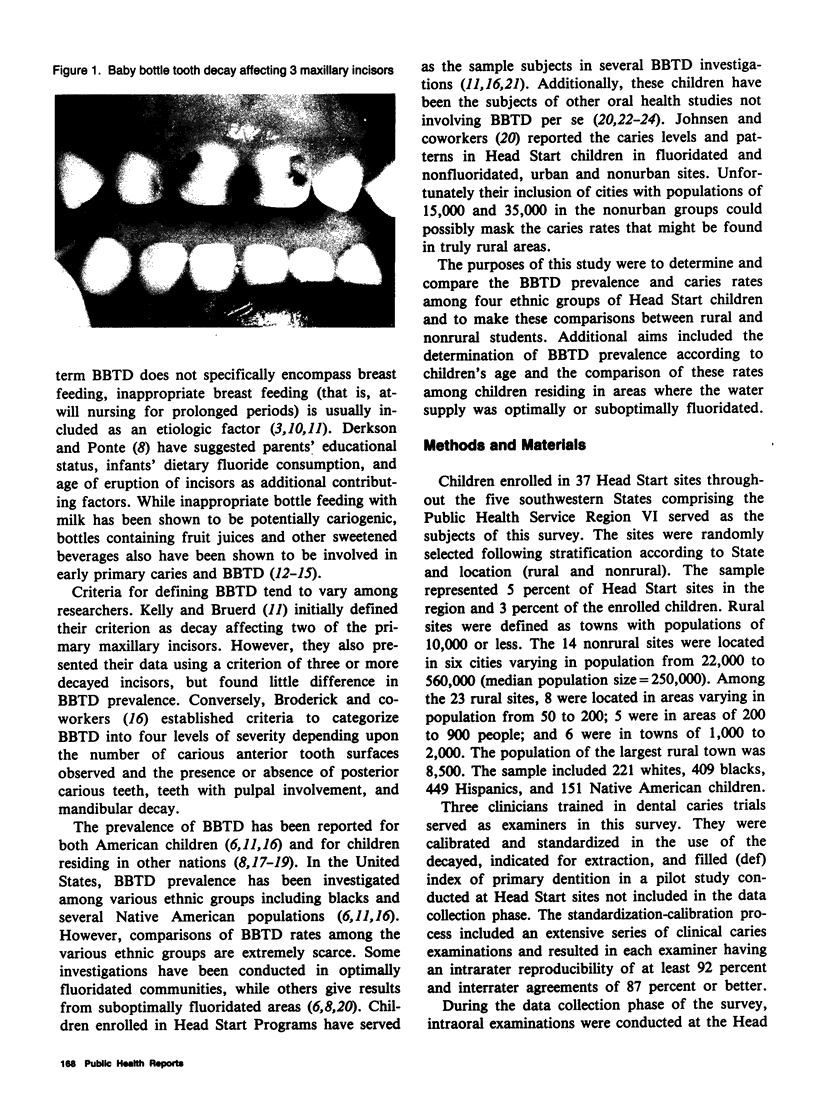
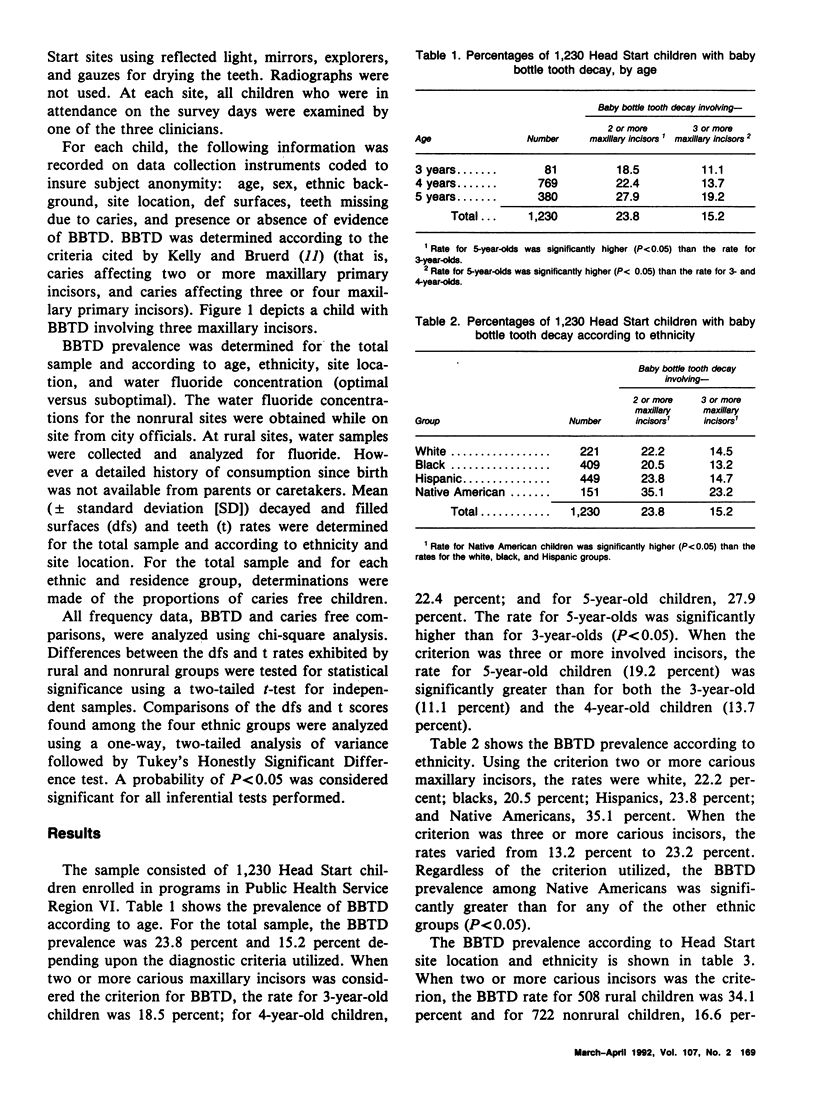
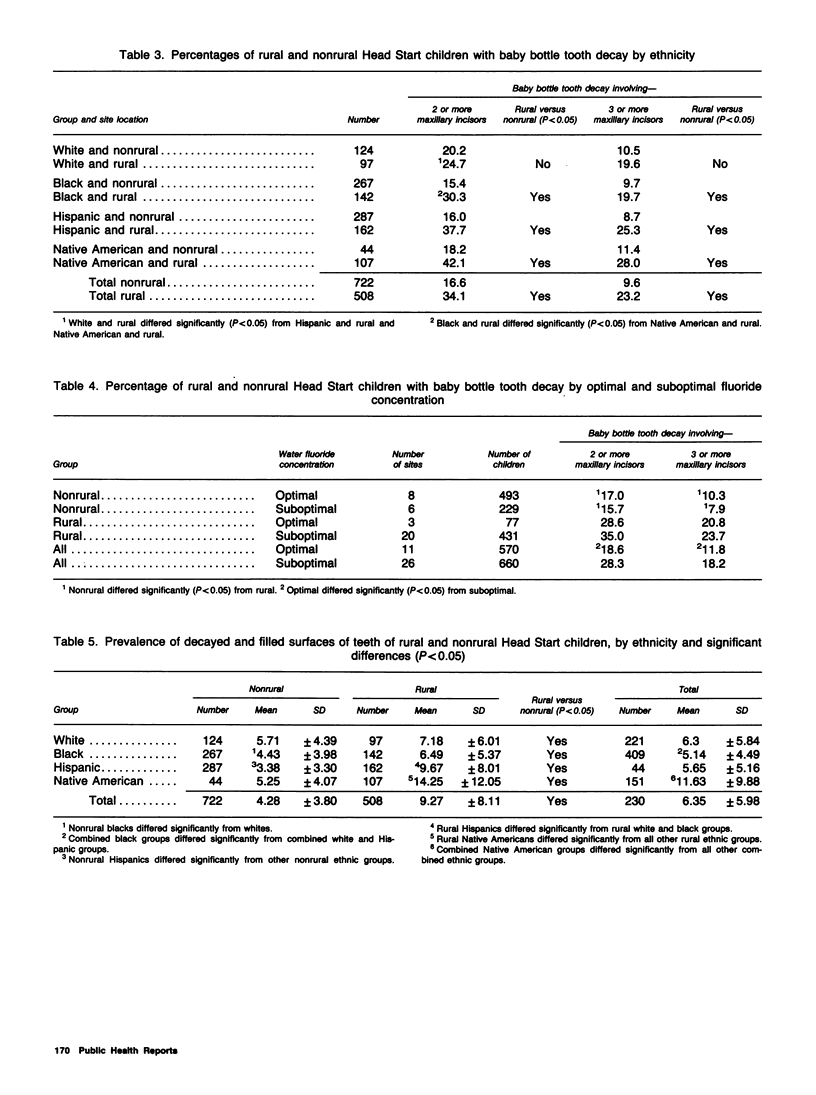
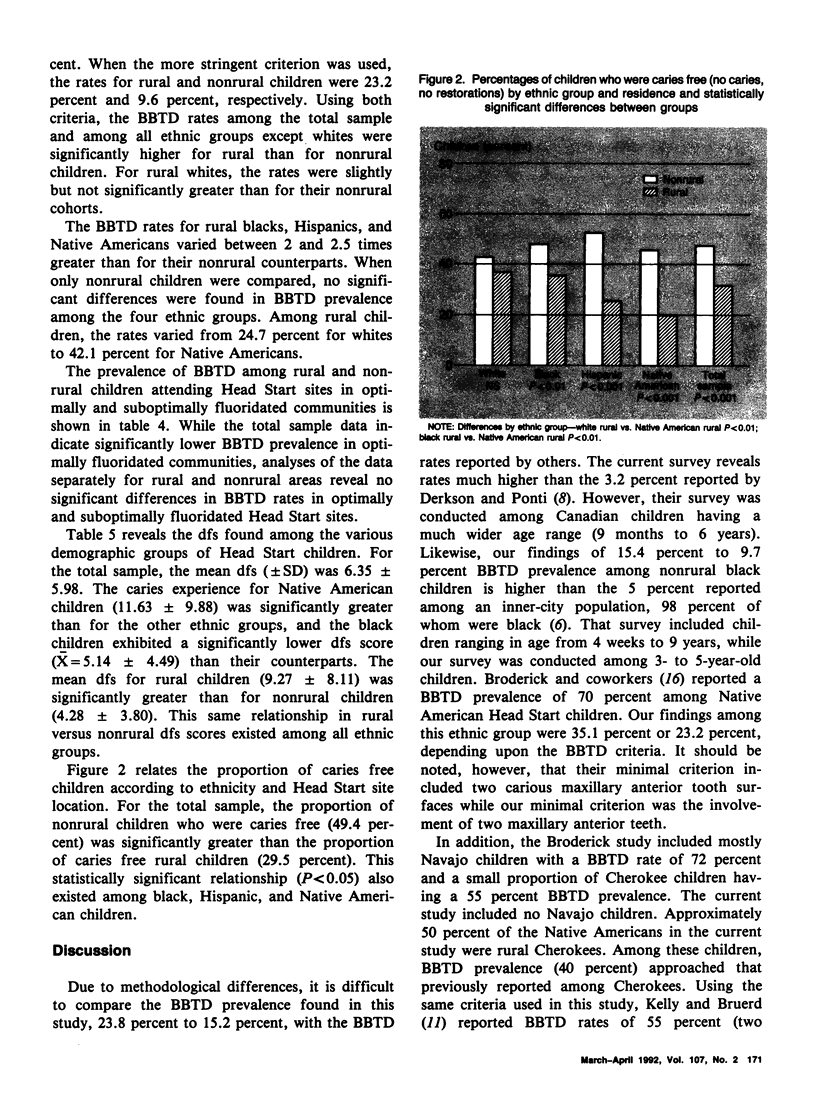
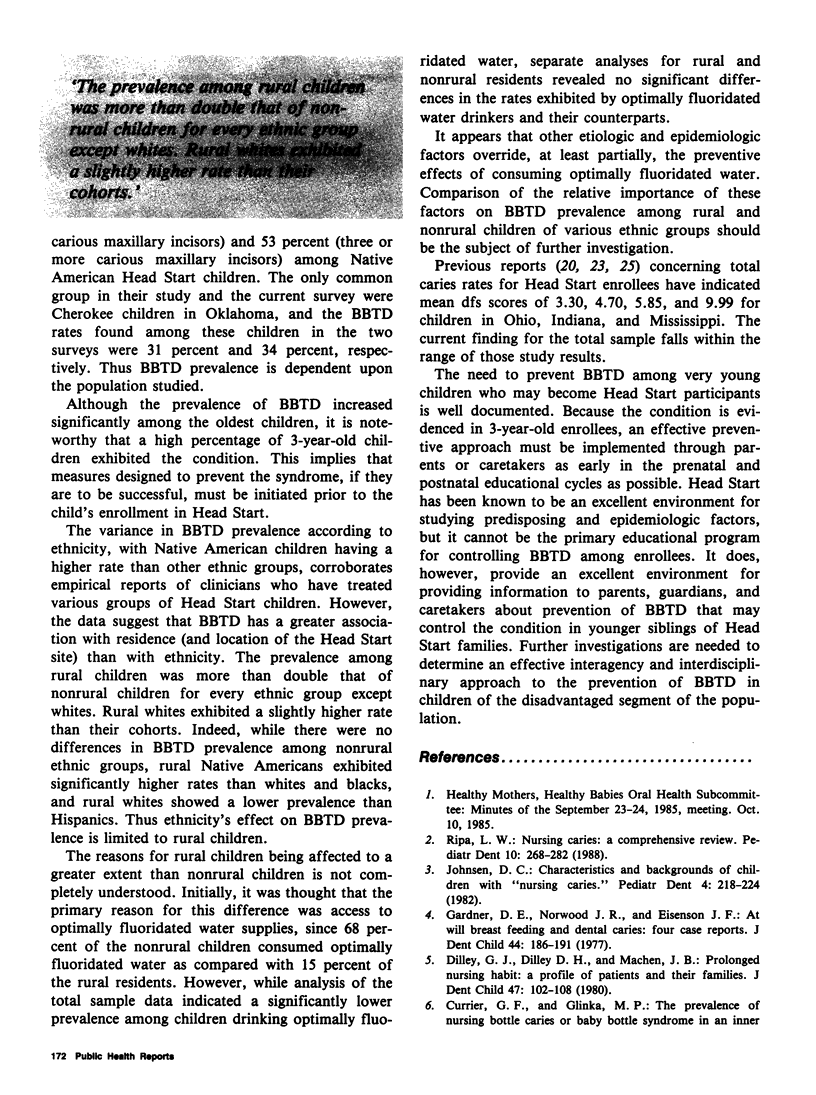
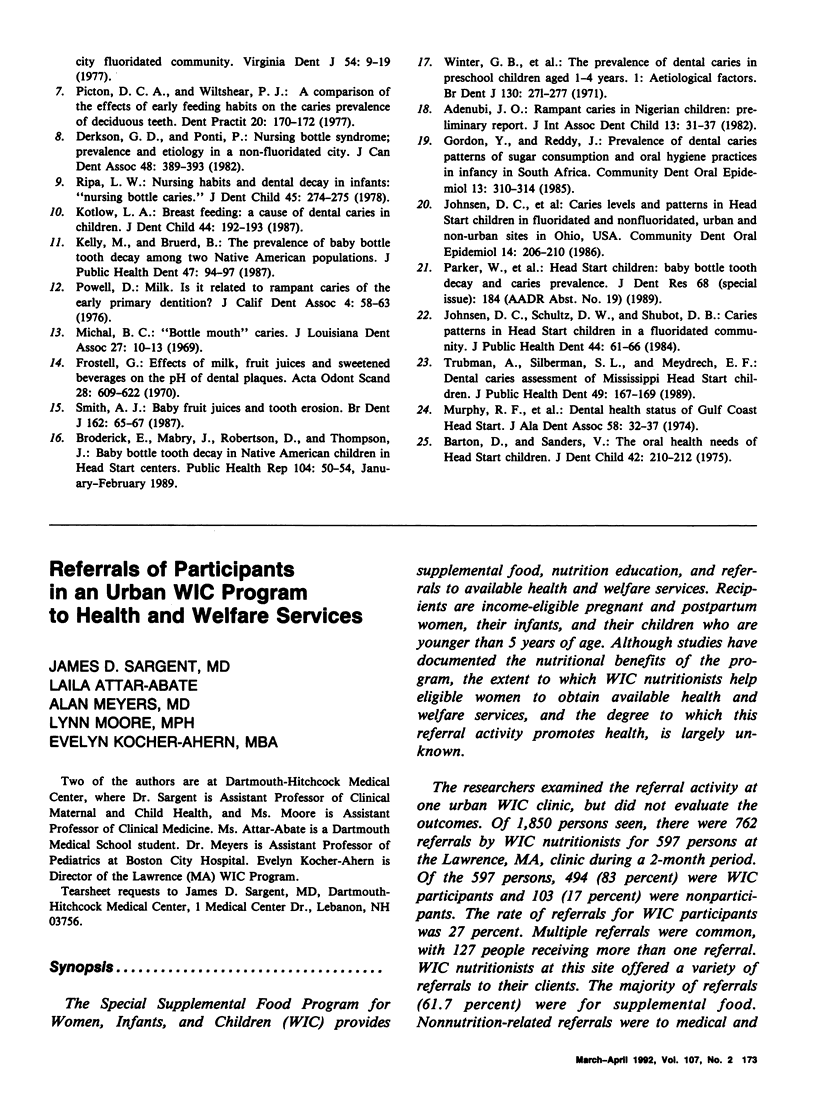
Images in this article
Selected References
These references are in PubMed. This may not be the complete list of references from this article.
- Adenubi J. O. Rampant caries in Nigerian children: preliminary report. J Int Assoc Dent Child. 1982 Jun;13(1):31–37. [PubMed] [Google Scholar]
- Barton D. H., Saunders V. The oral health needs of Head Start children. ASDC J Dent Child. 1975 May-Jun;42(3):210–212. [PubMed] [Google Scholar]
- Broderick E., Mabry J., Robertson D., Thompson J. Baby bottle tooth decay in Native American children in Head Start centers. Public Health Rep. 1989 Jan-Feb;104(1):50–54. [PMC free article] [PubMed] [Google Scholar]
- Currier G. F., Glinka M. P. The prevalence of nursing bottle caries or baby bottle syndrome in an inner city fluoridated community. Va Dent J. 1977 Oct;54(5):9–19. [PubMed] [Google Scholar]
- Derkson G. D., Ponti P. Nursing bottle syndrome; prevalence and etiology in a non-fluoridated city. J Can Dent Assoc. 1982 Jun;48(6):389–393. [PubMed] [Google Scholar]
- Dilley G. J., Dilley D. H., Machen J. B. Prolonged nursing habit: a profile of patients and their families. ASDC J Dent Child. 1980 Mar-Apr;47(2):102–108. [PubMed] [Google Scholar]
- Gardner D. E., Norwood J. R., Eisenson J. E. At-will breast feeding and dental caries: four case reports. ASDC J Dent Child. 1977 May-Jun;44(3):186–191. [PubMed] [Google Scholar]
- Gordon Y., Reddy J. Prevalence of dental caries, patterns of sugar consumption and oral hygiene practices in infancy in S. Africa. Community Dent Oral Epidemiol. 1985 Dec;13(6):310–314. doi: 10.1111/j.1600-0528.1985.tb00462.x. [DOI] [PubMed] [Google Scholar]
- Johnsen D. C., Bhat M., Kim M. T., Hagman F. T., Allee L. M., Creedon R. L., Easley M. W. Caries levels and patterns in head start children in fluoridated and non-fluoridated, urban and non-urban sites in Ohio, USA. Community Dent Oral Epidemiol. 1986 Aug;14(4):206–210. doi: 10.1111/j.1600-0528.1986.tb01536.x. [DOI] [PubMed] [Google Scholar]
- Johnsen D. C. Characteristics and backgrounds of children with "nursing caries". Pediatr Dent. 1982 Sep;4(3):218–224. [PubMed] [Google Scholar]
- Johnsen D. C., Schultz D. W., Schubot D. B., Easley M. W. Caries patterns in Head Start children in a fluoridated community. J Public Health Dent. 1984 Spring;44(2):61–66. doi: 10.1111/j.1752-7325.1984.tb03049.x. [DOI] [PubMed] [Google Scholar]
- Kelly M., Bruerd B. The prevalence of baby bottle tooth decay among two native American populations. J Public Health Dent. 1987 Spring;47(2):94–97. doi: 10.1111/j.1752-7325.1987.tb01983.x. [DOI] [PubMed] [Google Scholar]
- Kotlow L. A. Breast feeding: a cause of dental caries in children. ASDC J Dent Child. 1977 May-Jun;44(3):192–193. [PubMed] [Google Scholar]
- Michal B. C. "Bottle-mouth" caries. J La Dent Assoc. 1969 Fall;27(2):10–13. [PubMed] [Google Scholar]
- Murphy R. F., Morgan P. M., Willis R. A., Hubbard D. W., Goldsby J. W., Shory N. L. Dental health status of Gulf Coast Head Start. J Ala Dent Assoc. 1974 Jan;58(1):32–37. [PubMed] [Google Scholar]
- Picton D. C., Wiltshear P. J. A comparison of the effects of early feeding habits on the caries prevalence of deciduous teeth. Dent Pract Dent Rec. 1970 Jan;20(5):170–172. [PubMed] [Google Scholar]
- Powell D. Milk...is it related to rampant caries of the early primary dentition? J Calif Dent Assoc. 1976 Jan;4(1):58–63. [PubMed] [Google Scholar]
- Ripa L. W. Nursing caries: a comprehensive review. Pediatr Dent. 1988 Dec;10(4):268–282. [PubMed] [Google Scholar]
- Ripa L. W. Nursing habits and dental decay in infants: "nursing bottle caries". ASDC J Dent Child. 1978 Jul-Aug;45(4):274–275. [PubMed] [Google Scholar]
- Smith A. J., Shaw L. Baby fruit juices and tooth erosion. Br Dent J. 1987 Jan 24;162(2):65–67. doi: 10.1038/sj.bdj.4806027. [DOI] [PubMed] [Google Scholar]
- Trubman A., Silberman S. L., Meydrech E. F. Dental caries assessment of Mississippi Head Start children. J Public Health Dent. 1989 Summer;49(3):167–169. doi: 10.1111/j.1752-7325.1989.tb02055.x. [DOI] [PubMed] [Google Scholar]
- Winter G. B., Rule D. C., Mailer G. P., James P. M., Gordon P. H. The prevalence of dental caries in pre-school children aged 1 to 4 years. 1. Etiological factors. Br Dent J. 1971 Apr 6;130(7):271–277. doi: 10.1038/sj.bdj.4802662. [DOI] [PubMed] [Google Scholar]



